- Joined
- Feb 1, 2015
- Messages
- 9,995
Fifty years ago, I bought a Come-along. For more than thirty years, it served me well, lifting engines, pulling stuck tractors out, and countless other tasks. The teeth on the ratchet had worn down and one finally sheared off so a new Come-along was purchased and the old one hung up in the forge.
A few days ago, I decided to look at it to see it it could be repaired now that I had a CNC mill. The OEM drum and ratchet were made from die cast aluminum and on inspection, it looked like the easier path was just to make the ratchet mechanism.
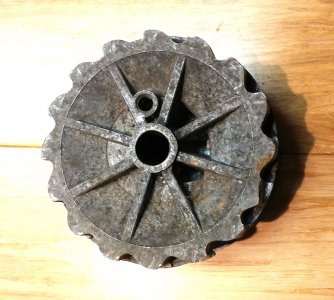
The worn ratchet. Note the broken tooth at 3:30.
I selected a piece of 1/2" 6061 plate for the new ratchet. I turned the old teeth off the drum, leaving a .270" boss and turned the remaining hub to a 1.875"diameter. (I decided to retain the original hub as it contained the cable fixing screw and it would have been impossible to match the screw threads in the new plate and a clearance hole in the new plate would have decreased the clamping force available.)
I modeled the new ratchet plate in SolidWorks.
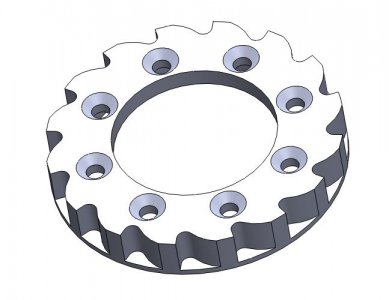
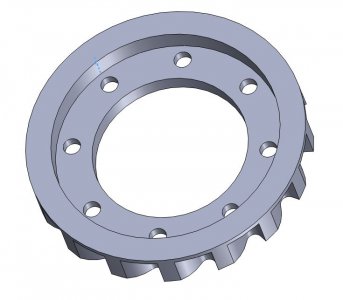
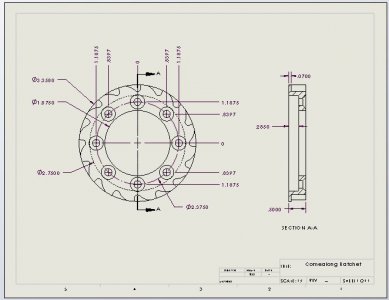
Then, I roughed out the plate on the H/V band saw so I could mount it in the lathe. I cut the bore and counterbore for a medium press fit to the drum. The fit was tight enough that I could turn the O.D. of the plate to about .050" oversized. This wasn't really necessary but it made the subsequent milling cuts more uniform.
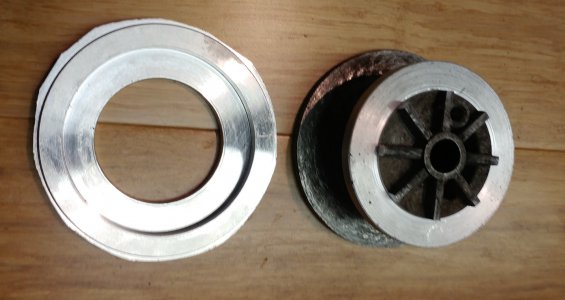
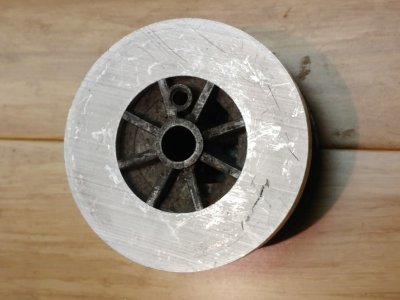
What appears to be a crack in the second photo is just a surface scratch
The next step was to mount the assembly on the Tormach table, using three step clamps. A .451" dowel pin on the hub provided a tight fit for locating the center of the drum assembly. I located the pin with my edge finder and zeroed my DRO I located the positions of the eight 1/4-20 screws per the drawing and center drilled, drilled, tapped, and countersunk the eight holes.
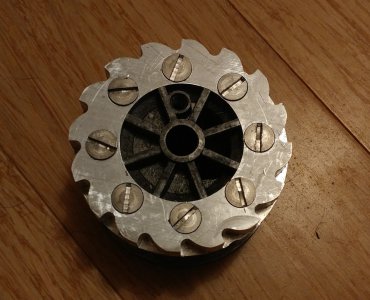
With the drum still mounted, I ran the milling program to cut the teeth of the ratchet, using a 1/4" end mill to profile the teeth and a 3/16" end mill to cut the bottoms of the gullets. Originally, I was going to use red LocTite to increase the gripping force of the assembly parts but I decided that the eight 1/4-20 S.S. screws had more than enough shear strength.
I cut the excess length of the screws in situ and cut them flush with the drum surface in the lathe. The Come-along was then reassembled, ready for another thirty years of service.
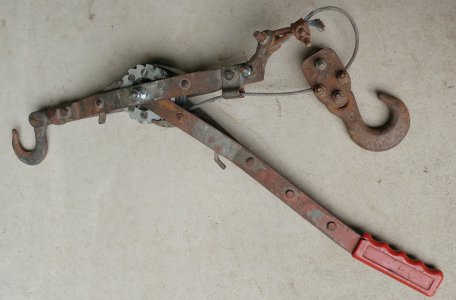
A few days ago, I decided to look at it to see it it could be repaired now that I had a CNC mill. The OEM drum and ratchet were made from die cast aluminum and on inspection, it looked like the easier path was just to make the ratchet mechanism.

The worn ratchet. Note the broken tooth at 3:30.
I selected a piece of 1/2" 6061 plate for the new ratchet. I turned the old teeth off the drum, leaving a .270" boss and turned the remaining hub to a 1.875"diameter. (I decided to retain the original hub as it contained the cable fixing screw and it would have been impossible to match the screw threads in the new plate and a clearance hole in the new plate would have decreased the clamping force available.)
I modeled the new ratchet plate in SolidWorks.



Then, I roughed out the plate on the H/V band saw so I could mount it in the lathe. I cut the bore and counterbore for a medium press fit to the drum. The fit was tight enough that I could turn the O.D. of the plate to about .050" oversized. This wasn't really necessary but it made the subsequent milling cuts more uniform.


What appears to be a crack in the second photo is just a surface scratch
The next step was to mount the assembly on the Tormach table, using three step clamps. A .451" dowel pin on the hub provided a tight fit for locating the center of the drum assembly. I located the pin with my edge finder and zeroed my DRO I located the positions of the eight 1/4-20 screws per the drawing and center drilled, drilled, tapped, and countersunk the eight holes.

With the drum still mounted, I ran the milling program to cut the teeth of the ratchet, using a 1/4" end mill to profile the teeth and a 3/16" end mill to cut the bottoms of the gullets. Originally, I was going to use red LocTite to increase the gripping force of the assembly parts but I decided that the eight 1/4-20 S.S. screws had more than enough shear strength.
I cut the excess length of the screws in situ and cut them flush with the drum surface in the lathe. The Come-along was then reassembled, ready for another thirty years of service.



